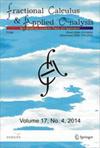重构带源的分数演化方程
IF 2.9
2区 数学
Q1 MATHEMATICS
引用次数: 0
摘要
我们关注的是重建有源分式演化方程的逆问题。为此,我们利用对边界解的观测来重构算子的主部和时间导数的分数阶,同时利用时间 T 的超确定性来通过非迭代法恢复源。数值示例解释了如何利用有限数据计算分数阶和源。本文章由计算机程序翻译,如有差异,请以英文原文为准。

Reconstruction of a fractional evolution equation with a source
We are concerned with the inverse problem of reconstructing a fractional evolution equation with a source. To this end we use observations of the solution on the boundary to reconstruct the principal part of the operator and the fractional order of the time derivative, while an overdetermination at a time T is used to recover the source by a non iterative method. Numerical examples explain how to compute the fractional order and the source using finite data.
求助全文
通过发布文献求助,成功后即可免费获取论文全文。
去求助
来源期刊

Fractional Calculus and Applied Analysis
MATHEMATICS, APPLIED-MATHEMATICS, INTERDISCIPLINARY APPLICATIONS
CiteScore
4.70
自引率
16.70%
发文量
101
期刊介绍:
Fractional Calculus and Applied Analysis (FCAA, abbreviated in the World databases as Fract. Calc. Appl. Anal. or FRACT CALC APPL ANAL) is a specialized international journal for theory and applications of an important branch of Mathematical Analysis (Calculus) where differentiations and integrations can be of arbitrary non-integer order. The high standards of its contents are guaranteed by the prominent members of Editorial Board and the expertise of invited external reviewers, and proven by the recently achieved high values of impact factor (JIF) and impact rang (SJR), launching the journal to top places of the ranking lists of Thomson Reuters and Scopus.
 求助内容:
求助内容: 应助结果提醒方式:
应助结果提醒方式:


